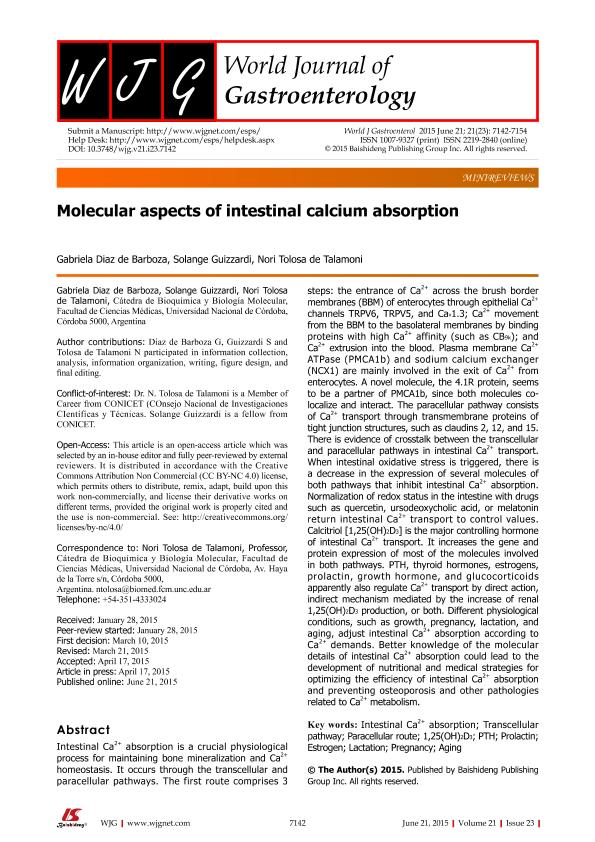Mostrar el registro sencillo del ítem
dc.contributor.author
Díaz de Barboza, Gabriela
dc.contributor.author
Guizzardi, Solange Natali

dc.contributor.author
Tolosa, Nori Graciela

dc.date.available
2017-01-16T18:52:22Z
dc.date.issued
2015-06
dc.identifier.citation
Díaz de Barboza, Gabriela; Guizzardi, Solange Natali; Tolosa, Nori Graciela; Molecular aspects of intestinal calcium absorption; W J G Press; World Journal Of Gastroenterology; 21; 23; 6-2015; 7142-7154
dc.identifier.issn
1007-9327
dc.identifier.uri
http://hdl.handle.net/11336/11398
dc.description.abstract
Intestinal Ca2+ absorption is a crucial physiological process for maintaining bone mineralization and Ca2+ homeostasis. It occurs through the transcellular and paracellular pathways. The first route comprises 3 steps: the entrance of Ca2+ across the brush border membranes (BBM) of enterocytes through epithelial Ca2+ channels TRPV6, TRPV5, and Cav1.3; Ca2+ movement from the BBM to the basolateral membranes by binding proteins with high Ca2+ affinity (such as CB9k); and Ca2+ extrusion into the blood. Plasma membrane Ca2+ ATPase (PMCA1b) and sodium calcium exchanger (NCX1) are mainly involved in the exit of Ca2+ from enterocytes. A novel molecule, the 4.1R protein, seems to be a partner of PMCA1b, since both molecules colocalize and interact. The paracellular pathway consists of Ca2+ transport through transmembrane proteins of tight junction structures, such as claudins 2, 12, and 15. There is evidence of crosstalk between the transcellular and paracellular pathways in intestinal Ca2+ transport. When intestinal oxidative stress is triggered, there is a decrease in the expression of several molecules of both pathways that inhibit intestinal Ca2+ absorption. Normalization of redox status in the intestine with drugs such as quercetin, ursodeoxycholic acid, or melatonin return intestinal Ca2+ transport to control values. Calcitriol [1,25(OH)2D3] is the major controlling hormone of intestinal Ca2+ transport. It increases the gene and protein expression of most of the molecules involved in both pathways. PTH, thyroid hormones, estrogens, prolactin, growth hormone, and glucocorticoids apparently also regulate Ca2+ transport by direct action, indirect mechanism mediated by the increase of renal 1,25(OH)2D3 production, or both. Different physiological conditions, such as growth, pregnancy, lactation, and aging, adjust intestinal Ca2+ absorption according to Ca2+ demands. Better knowledge of the molecular details of intestinal Ca2+ absorption could lead to the development of nutritional and medical strategies for optimizing the efficiency of intestinal Ca2+ absorption and preventing osteoporosis and other pathologies related to Ca2+ metabolism.
dc.format
application/pdf
dc.language.iso
eng
dc.publisher
W J G Press

dc.rights
info:eu-repo/semantics/openAccess
dc.rights.uri
https://creativecommons.org/licenses/by-nc-sa/2.5/ar/
dc.subject
Intestinal Calcium Absorption
dc.subject
Transcellular Pathway
dc.subject
1,25(Oh)2d3
dc.subject
Pth
dc.subject.classification
Bioquímica y Biología Molecular

dc.subject.classification
Medicina Básica

dc.subject.classification
CIENCIAS MÉDICAS Y DE LA SALUD

dc.title
Molecular aspects of intestinal calcium absorption
dc.type
info:eu-repo/semantics/article
dc.type
info:ar-repo/semantics/artículo
dc.type
info:eu-repo/semantics/publishedVersion
dc.date.updated
2017-01-13T20:06:48Z
dc.identifier.eissn
2219-2840
dc.journal.volume
21
dc.journal.number
23
dc.journal.pagination
7142-7154
dc.journal.pais
Estados Unidos

dc.journal.ciudad
Pleasanton
dc.description.fil
Fil: Díaz de Barboza, Gabriela. Universidad Nacional de Cordoba. Facultad de Medicina. Catedra de Bioquimica y Biologia Molecular; Argentina
dc.description.fil
Fil: Guizzardi, Solange Natali. Universidad Nacional de Cordoba. Facultad de Medicina. Catedra de Bioquimica y Biologia Molecular; Argentina. Consejo Nacional de Investigaciones Científicas y Técnicas; Argentina
dc.description.fil
Fil: Tolosa, Nori Graciela. Universidad Nacional de Cordoba. Facultad de Medicina. Catedra de Bioquimica y Biologia Molecular; Argentina. Consejo Nacional de Investigaciones Científicas y Técnicas; Argentina
dc.journal.title
World Journal Of Gastroenterology

dc.relation.alternativeid
info:eu-repo/semantics/altIdentifier/url/http://www.wjgnet.com/1007-9327/full/v21/i23/7142.htm
dc.relation.alternativeid
info:eu-repo/semantics/altIdentifier/url/https://www.ncbi.nlm.nih.gov/pmc/articles/PMC4476875/
dc.relation.alternativeid
info:eu-repo/semantics/altIdentifier/url/http://dx.doi.org/10.3748/WJG.v21.i23.7142
Archivos asociados
